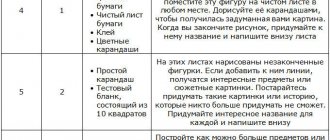There is a wide variety of problems that require different types of thinking to solve. In psychology, it is customary to divide thinking into discursive and intuitive. Discursive thinking is a thought process during which a person sequentially goes through different types of solutions to a problem. Let's take a closer look at this type of thinking and find out how it works.
What is discursive thinking?
The concept of “discursive” comes from the Latin “discursus”, which translates as “reasoning”. That is, in the process of such thinking, a person finds the answer to a question that interests him as a result of dialogue with himself. He selects the necessary key to the solution in the same way as a child acts when putting together a jigsaw puzzle. By alternately “substituting” first one or the other of his assumptions, based on logical conclusions, a person makes his own conclusion. And both deduction and induction can be used:
- deduction involves a transition from general concepts to a particular case;
- induction involves moving from a particular judgment to a general conclusion.
For example, it’s easy to guess that if a child’s school is quarantined, most of his colleagues are sneezing at work, and there are queues at pharmacies, then a flu or ARVI epidemic has come to the city. However, such conclusions are not always so clear-cut. Statements like “all men are goats”, “all women are fools”, “all children are capricious”, “all salesmen are thieves” and so on are also made on the principles of induction.
To avoid them, you need to act according to the following instructions.
- Collect information with a “cool” head. Don't attach your own feelings and prejudices to it.
- Analyze the information received. Perhaps it will be possible to derive some patterns. Make a comparison - find similarities and differences.
- Now you can draw a conclusion about the event, phenomenon or person you are interested in.
- Check the received data. To make a final verdict, find evidence to support your conclusions. To do this, once again examine the facts and circumstances or simply observe what is happening.
Such techniques help not only to correctly assess the situation, but also to influence it. Discursive thinking can be useful both in everyday matters and in business.
Let's consider several situations. Your son doesn’t want to clean up his room. You have already told him more than once that he is unclean and demanded that he clean his six square meters. However, the cart with its socks, CDs, books, notebooks, pants and T-shirts is still there.
Let’s try to approach it from the other side: “Dear child, look how pleasant it is to be in your sisters’ room. Everything is sorted out there, they quickly find their things and don’t stumble over various obstacles, isn’t it time for you to create some comfort?” Most likely, such a proposal will be much more successful than a comparison with a pig and orders given in the form of an ultimatum.
Your daughter cried all day when you canceled your trip to the zoo because of the rain. Remember what you told her. Most likely, it sounded something like this: “We’re not going to the menagerie - it’s damp outside.” If the next time the “heavenly office” gets in your way again, the following wording is recommended: “Today strong winds and rain are expected, it’s terribly uncomfortable to walk in such conditions, let’s reschedule the walk until next weekend.” You'll see, your daughter will thank you for taking such good care of her.
There is no way you can sell a batch of soap that was developed by the best specialists of your company. What do sellers tell buyers? “This is our most successful product. It contains only natural ingredients. It gives a wonderful aroma to the body and freshness to the skin.”
“Flip” the presentation. This soap will make your skin smooth, give an unforgettable aroma, will not cause allergic reactions, as it is made from natural ingredients, and, by the way, this is one of our most successful finds. Is there already a line at the counter?
To do this, memory, observation, ability to concentrate and analytical data must be well developed. In psychology, this type of thinking is called slow, while another type is considered fast - intuitive.
Correct Interpretation
In fact, it is not enough to see the situation from the inside yourself. You also need to be able to interpret this correctly and give an objective assessment of what is happening. Based on logical thinking, a person can come to quite bold and ambiguous conclusions that under other circumstances simply would not come to mind.
Without such a skill, it is impossible to defend one’s position and develop in the chosen direction. An individual must constantly strive to double-check his guesses and make sure that he is right.
Thus, the types of discursive thinking listed above are necessary in order to competently structure the communication process. It is necessary to understand that the main thing here is to be able to listen correctly to your interlocutor, adequately perceive the emerging situation and draw certain conclusions. Then a person will be able to be in harmony with himself and with society. In any relationship you must invest creative energy, analyze what is happening around you and know exactly what certain actions can lead to.
Modern thinking concepts
At the present stage, human thinking is the object of research in many sciences: psychology, sociology, logic, theory of artificial intelligence, etc.
- The psychological concept of thinking is built on the principles of the unity of activity and thinking, sociohistorical and cultural determination, development, systematicity, reflection. Modern psychology distinguishes intellectual (other) and intellectual operations (analysis, synthesis, comparison, generalization, etc.) in thinking.
- Sociological and socio-psychological concept of thinking.
- Logical-philosophical concept of thinking.
- Information-cybernetic concept of thinking.
- Heuristic concept of thinking.
How does intuitive thinking work?
Some people have developed intuitive thinking. They are able to solve problems without thinking about them, without conducting a logical and critical analysis of the situation. The answer to the task comes to them from within, from the subconscious.
Intuitive thinking involves subconscious processes. It works automatically in situations familiar to humans. For example, while driving a car, a person performs all operations unconsciously: he does not think about which way to turn the steering wheel, how to change gear or when to press the brake pedal. All this happens automatically because the person already has driving experience.
It also happens in any activity in which a person is well versed and has experience. The worker at the machine also does not think about his every action, he performs them automatically. An experienced doctor can diagnose a common disease without any tests, just by looking at the patient.
To achieve this level in any profession, psychologists recommend a conscious approach to mastering a new type of activity. It is necessary to take each step slowly, thinking and remembering all the details, working through each action many times. Gradually, the skills will move to the subconscious level, and in the future the person will be able to perform them automatically.
Prelogical thinking
This concept was introduced by L. Lévy-Bruhl. The term turned out to be necessary to designate the early stage of the formation of the basic laws of logic. We are talking about that stage of formation when the meaning of cause-and-effect relationships is already clear and realized, but its essence is not entirely clear and is even mystified. The reason for the appearance of certain conditions is necessarily some higher power, natural or animal (an example of this is the use of a totem, worship of the forces of nature, etc.). We are talking about that stage of human development when a severe thunderstorm or drought could be perceived as the wrath of the gods.
We should probably end here. Of course, there are many other types. But the ones we mentioned can be called the most basic. Now you know that in addition to the logical, there is also an intuitive type of thinking, and in addition to the practical, there is a pre-logical one. But keep in mind, it is not always possible to say that a particular person uses only one specific type. Most often, in different situations, people resort to different thought processes, often without controlling their choices.
Basic functions of thinking
- Cognitive (reflection of the world and self-reflection)
- Design (construction of plans, projects, models of practical and theoretical-cognitive activities)
- Forecasting (forecasting or anticipating the consequences of one’s actions, one’s activities, predicting the future)
- Informational (assimilation of information about knowledge and its semantic processing)
- Technological (development of rules, norms, standards, recipes for the lifestyle of man and society in various forms and manifestations)
- Reflective (self-knowledge of the mind, introspection)
- Interpretation (interpretation, understanding of the products of human culture)
- Analytical and synthetic
- Setting and solving various tasks and problems
Definition
The difficulty in formulating this concept lies in the fact that almost every adult has an idea of what exactly is called thinking. This is a way or means of obtaining information about the world around us and the processes occurring in it. It is indirect and generalizing in nature.
There are different types (types) of this process. These include: discursive, imaginative, intuitive, rational, practical and pre-logical thinking. Each of them is radically different in some ways, and in some ways, on the contrary, may be similar to any others. Let's find out what their differences and similarities are. In addition to types, the thought process has two forms: inference and judgment.
Inference is the result of all judgments, the final conclusion obtained from the information provided. There are only three types:
- deductive;
- inductive;
- Similarly.
It is worth considering each of them in more detail so that the subsequent information will be more understandable to you. Deductive is done on the basis of general rules in relation to any particular case. Reliable facts are taken as a basis, and on their basis a person comes to some conclusion. Let's give the simplest example. Metals are ductile, iron is a metal. This means it is plastic. With the inductive method, the individual, on the contrary, proceeds to a general judgment based on a particular case. An inference by analogy is one that is arrived at based on the similarity of two (or several) cases, objects or any properties.
A judgment is a separate thought about an object. By connecting them into a single chain, you can come to a certain conclusion. For example: “A person who committed a crime must be punished” is a judgment.
Deductive principle
Subject to the opposite pattern: the conclusion is drawn from the general to the specific. Usually people do not notice how they come to a certain decision, they cannot track the progress of their thoughts. That is, based on some general belief, you can come to a personal conclusion. Often people use the deductive method without even realizing it or thinking about what is happening. An example is the following situation: having become acquainted with the main work of a famous author, a person decides to read his early book, which few people know about, sincerely believing that it will also be incredibly exciting. Often people generally tend to do something out of emotion, under the influence of strong impressions.
The concept of “thinking” in the history of philosophy
The concept of thinking is in close connection with It is fundamental in the conceptual knowledge systems of philosophers of the past and present. The concept of thinking (gr. ???? - mind) and related concepts were formed by ancient philosophers and others).
According to Aristotle, thinking is part of the soul, another part of it is sensation. As a part of the soul, thinking is a specific ability to reason, to comprehend the world and oneself through opinion, that is, the soul. Thinking is an activity aimed at cognition and comprehension of the types of things. Exploring thinking, Aristotle created logic - the science of thinking, formulated laws and forms of thinking.
In the conceptual systems of modern philosophers (John Locke, Francis Bacon, Claude Adrian Helvetius, David Hume), thinking is an activity aimed at knowledge and practical action; it develops a method, i.e. a means, a method of cognition and practical action. Philosophers distinguish manifestations of thinking - sensation, contemplation, imagination, reflection; level of thinking - reason, mind; manifestations of thinking activity - doubt, faith, design, decision-making, understanding, imaginary transactions.
In the conceptual systems of representatives of classical German philosophy (Kant, Johann Gottlieb Fichte, Friedrich Wilhelm Schelling, Georg Hegel), thinking is considered as an act of self-activity of the subject, which gives rise to various intellectual, imaginary phenomena - concepts, principles, laws, ideas, ideals, i.e. knowledge.
Emmanuel Kant noted the spontaneity of acts of thinking, the a priori nature of its activity, the focus on knowledge through concepts, and identified levels of thinking - intuition, reason, reason; types and types of thinking - formal-logical (rational) and dialectical (reasonable), concrete and abstract, practical and theoretical. E. Kant defined the one-sidedness, limitations of reason and the antinomy of reason, and established connections between “pure” thinking and sensuality, with the outside world.
Hegel defines thinking as the activity of a subject aimed at understanding the world in the form of concepts (categories). The highest form of knowledge is science (philosophy), which cognizes the Absolute Spirit. Thinking is knowledge in the concepts (categories) of the Absolute Spirit, thanks to which universal knowledge is formed.
Lecture No. 8. Thinking (part 1)
Thinking in psychology is defined as a process of human cognitive activity, which is an indirect and generalized reflection of reality by a person in its essential connections and relationships.
A person’s knowledge of the surrounding reality begins with sensations and perceptions. However, the sensory picture of the world that our sensations and perceptions create, although necessary, is not sufficient for its deep, comprehensive knowledge. In this picture of reality, there is practically no idea of the complex interactions of various objects: objects, events, phenomena, etc. There is no explanation of the cause-and-effect relationships between them, their transitions into each other. Based on the data of sensations and perceptions and going beyond the sensory, thinking expands the boundaries of our knowledge. It allows you to indirectly, through inference, comprehend what is not given directly in perception. Thinking correlates the data of sensations and perceptions, compares them, and reveals their interaction. Thus, with the help of thinking, natural relationships between phenomena and objects are revealed and random coincidences are eliminated.
But, considering thinking as a relatively independent cognitive function, we should not forget that any type of thinking, even the most developed (abstract thinking), cannot be divorced from sensory knowledge of the world, since every cognitive process begins with sensations and perception. It is they who determine the adequacy of thinking as a reflection, ensuring a direct connection of human consciousness with the outside world. This reflection is continuously tested and confirms its adequacy in the process of practical activity.
Types of thinking
distinguished according to various characteristics. The main accepted classification distinguishes the following three types:
1) visual and effective thinking;
2) visual-figurative thinking;
3) verbal-logical (or conceptual) thinking.
It is in this order that types of thinking develop in the process of phylogeny and ontogenesis.
Visual-effective thinking is a type of thinking based on the direct perception of objects. The solution of the problem within its framework is carried out in the course of a real, physical transformation of the situation, in the process of actions with objects. Through physical contact with objects, their properties are comprehended.
In the process of phylogenesis, people solved the problems that confronted them, first within the framework of practical, objective activity. Only later did theoretical activity emerge from it. This also applies to thinking. Only as practical activity develops does theoretical thinking activity stand out as relatively independent. A similar process is observed not only during the historical development of mankind, but also in ontogenesis. The formation of a child’s thinking occurs gradually. First, it develops within practical activity and is largely determined by how the ability to handle objects develops.
At the initial stage of child development, such manipulation occurs spontaneously and without meaning. Further, the nature of the actions begins to acquire meaning and is determined by the qualities of the object with which the child interacts. On this basis, the earliest genetic type of thinking is formed - visual-effective. Its first manifestations can be observed already at the end of the first - beginning of the second year of a child’s life. In preschool age (up to 3 years inclusive), this type of thinking is predominant. Already the child’s first objective actions allow him to identify the characteristic features of the object of manipulation and its relationship with other objects. The child learns about objects in the surrounding world through direct contact with them. He correlates with each other certain objects or parts of objects that he perceives at the moment, both visually and through actions. Collecting pyramids, folding cubes and similar activities of a small child is nothing more than the process of comprehending the world of objects in a visually effective form, the process of developing a visually effective type of thinking. Slightly older children perform more complex manipulations, thereby learning through direct action more complex methods of articulating parts and objects.
The next type of thinking that appears in ontogenesis is visual-figurative thinking. This type is characterized by reliance on images of objects, on ideas about their properties. A person imagines a situation, imagines the changes he wants to achieve, and those properties of objects that will allow him to achieve the desired result in the course of his activity. In this type of thinking, action with the image of objects and situations precedes real actions in the subject matter. When solving a problem, a person analyzes, compares, and generalizes various images. An image can contain a multifaceted vision of an object. Therefore, this type of thinking gives a more complete understanding of the properties of an object than visual-effective thinking.
The initial stages of visual-figurative thinking are formed in children in preschool age - from 4 to 7 years. Although the connection between thinking and practical actions is preserved, it fades into the background. To understand an object, a child no longer has to directly manipulate it. It is quite enough for him to have a clear and clear idea of this subject. At this stage of thinking development, children do not yet master concepts. Therefore, the first two types of thinking we considered belong to the pre-conceptual stage of thinking.
The transition to the conceptual stage is associated with the formation of the next type of thinking - verbal-logical. It represents the latest stage in the development of thinking in phylogeny and ontogenesis. Verbal-logical thinking is a type of thinking carried out using logical operations with concepts. Concepts are formed on the basis of linguistic means. The forerunner of verbal-logical thinking is inner speech. Children up to about 5 years old, even when playing alone, pronounce all their actions out loud and describe the manipulations. Closer to school age, they develop the ability for internal speech - they no longer speak out loud, but think through the sequence of their actions, that is, they begin to think not with the help of visual images, but with the help of words, which is the basis for the formation of concepts. However, the development of the verbal-logical type of thinking does not mean at all that the previous types cease to develop or even disappear completely. They continue to develop and improve under the influence of verbal and logical thinking. And in adulthood, all three types are present. There are many areas of activity in which visual-effective or visual-figurative thinking is necessary. For example, in the work of a designer one cannot do without a developed visual-effective type of thinking, and in the work of an artist or writer - without a visual-figurative one.
In addition to the classification of types of thinking in the “pre-conceptual - conceptual” plane, they are also distinguished by a number of different characteristics. Thus, they distinguish between theoretical and practical, intuitive and logical (analytical, discursive), realistic and autistic, productive and reproductive, voluntary and involuntary thinking.
Theoretical and practical types of thinking differ in the nature of the problems that need to be solved and, as a consequence of this, in a number of dynamic and structural aspects.
Theoretical thinking is the establishment of patterns in certain processes, the identification of cause-and-effect relationships, and the discovery of laws. This type of thinking is inherent in theoretical scientists and researchers. The tasks of practical thinking include the preparation and implementation of transformations of the world in terms of subject matter. Practical thinking is associated with setting goals, developing plans, projects, etc. Among modern activities, one can cite as an example the work of a programmer - when writing programs that ensure the functioning of production and product accounting, there is a considerable amount of practical thinking. In general, in the process of intense work activity, practical thinking often occurs under conditions of time shortage and the need to act in emergency mode. Therefore, practical thinking is no less complex than theoretical thinking.
Sometimes a contrast is made between theoretical thinking and empirical thinking. In this case, the criterion is different - the nature of the generalizations with which thinking deals. In the first case, these are scientific concepts, and in the second, everyday, situational generalizations.
Based on the degree of development, thinking is divided into analytical and intuitive. Analytical thinking is a process gradually unfolded over time, quite clearly represented in consciousness. The main characteristics of intuitive thinking, on the contrary, are rapidity, the absence of clearly defined stages and minimal awareness. Thus, to compare them, three characteristics are used: temporal (the time of the process), structural (division into stages), and the degree of awareness of the process.
According to the vector of direction, thinking is divided into realistic and autistic thinking. Realistic thinking is outward directed and governed by logic. Autistic thinking has the opposite vector - it is associated with a person’s desire to escape reality, delve into his inner world, and think in accordance with his own logic. It is sometimes also called egocentric thinking due to the reluctance and inability to accept someone else's point of view.
Based on the criterion of novelty and originality of the problems being solved, thinking is divided into productive (creative) and reproductive (reproducing). Productive thinking is aimed at creating a new way to solve a particular problem or improving an existing method. Reproductive thinking is characterized by the use of ready-made knowledge and skills.
According to the degree of involvement of volitional processes in thinking, it is divided into voluntary and involuntary. Voluntary thinking is involved in the purposeful solution of a given task. Involuntary thinking is a free flow of thoughts that does not pursue any goals (for example, contemplation of nature).
There are three logical forms of thinking
: concept, judgment, inference.
A concept is a reflection in the human mind of the distinctive features of objects and phenomena, their general and specific characteristics, expressed in a word or group of words. The concept represents the highest level of generalization, inherent only in the verbal-logical type of thinking. Concepts can be concrete or abstract. Concrete concepts reflect objects, phenomena, events of the surrounding world, abstract concepts reflect abstract ideas. For example, “person”, “autumn”, “holiday” are specific concepts; “truth”, “beauty”, “good” are abstract concepts.
The content of concepts is revealed in judgments, which also always have a verbal form. Judgment is the establishment of connections between concepts about objects and phenomena or their properties and characteristics. For example, “the boiling point of water + 100 °C” - this judgment reflects the relationship between changes in the physical properties of water and the heating temperature.
Judgments can be general, particular and individual. In general, something is stated about all objects of a certain group, for example: “All rivers flow.” A particular judgment applies only to some of the objects of the group: “Some rivers are mountainous.” A single judgment concerns only one object: “The Volga is the largest river in Europe.”
Judgments can be formed in two ways. The first is the direct expression of the perceived relationship of concepts. The second is the formation of judgment indirectly using inferences. Thus, inference is the derivation of a new judgment from two (or more) already existing judgments (premises). The simplest form of inference is a syllogism - a conclusion made on the basis of a particular and general judgment. For example: “All dogs have a highly developed sense of smell” - a general premise, “Doberman is one of the breeds of dogs” - a particular premise and conclusion (conclusion) - “Dobermans have a highly developed sense of smell.” Any process of proof, for example, a mathematical theorem, is a chain of syllogisms that consistently follow from one another.
More complex forms of inference are deductive and inductive inferences. Deductive - follow from general premises to a particular judgment and from particular to an individual. Inductive, on the contrary, derive general judgments from individual or particular premises.
Based on such methods of reasoning, it is possible to compare with each other certain concepts and judgments that a person uses in the course of his mental activity.
Thus, for the productive course of mental activity, logical forms of thinking are necessary. They determine persuasiveness, consistency, and, consequently, the adequacy of thinking. The idea of logical forms of thinking passed into psychology from formal logic. This science also studies the thinking process. But if the subject of formal logic is, first of all, the structure and result of thinking, then psychology studies thinking as a mental process, it is interested in how and why this or that thought arises and develops, how this process depends on the individual characteristics of a person, how it is connected with others mental processes.
The thinking process is carried out using a number of mental operations
: analysis and synthesis, abstraction and concretization, classification, systematization, comparison, generalization.
Analysis is the mental decomposition of an object into its component parts in order to isolate its various aspects, properties, and relationships from the whole. Through analysis, irrelevant connections given by perception are discarded.
Synthesis is the reverse process of analysis. This is the combination of parts, properties, actions, relationships into one whole. This reveals significant connections. Analysis and synthesis are two interrelated logical operations.
Analysis without synthesis leads to a mechanical reduction of the whole to the sum of its parts. Synthesis without analysis is also impossible, since it reconstructs the whole from the parts isolated by analysis. In the process of thinking, some people tend to gravitate toward analysis, others toward synthesis (analytical or synthetic mindset). Synthesis, like analysis, can be both practical and mental. But the formation of these processes, both in phylo- and ontogenesis, is based on the practical activity of man, his mastery of objects and phenomena of the surrounding world.
Comparison is the establishment between objects of similarity or difference, equality or inequality, etc. Comparison is based on analysis. In order to carry out this operation, you must first select one or more characteristic features of the objects being compared. Then, a comparison is made based on the quantitative or qualitative characteristics of these characteristics. The number of selected features determines whether the comparison will be one-sided, partial or complete. Comparison (as analysis and synthesis) can be at different levels - superficial and deep. In the case of deep comparison, a person’s thought moves from external signs of similarity and difference to internal ones, from the visible to the hidden, from appearance to essence. Comparison is the basis of classification—the assignment of objects with different characteristics to different groups.
Abstraction (or abstraction) is a mental distraction from minor, non-essential aspects, properties or connections of an object in a given situation and the isolation of one particular aspect or property. Abstraction is possible only as a result of analysis. So, for example, when examining an object, you can consider only its color or only its shape. A person mentally identifies some feature of an object and examines it in isolation from all other features, temporarily distracting from them. The separated feature becomes an independent object of thinking. Isolated study of individual features of an object while simultaneously abstracting from all others helps a person to better understand the essence of things and phenomena. Beginning with the isolation of individual sensory properties, abstraction then proceeds to the isolation of non-sensory properties expressed in abstract concepts.
Thanks to abstraction, man was able to break away from the individual, concrete and rise to the highest level of knowledge - scientific theoretical thinking.
Concretization is the opposite process. This is the movement of thought from the general to the particular, from the abstract to the concrete in order to reveal its content. Concretization is also used in the case when it is necessary to show the manifestation of the general in the individual.
Systematization is the arrangement of individual objects, phenomena, thoughts in a certain order according to any one characteristic (for example, chemical elements in D.I. Mendeleev’s periodic table).
Generalization is the unification of many objects according to some common characteristic. In this case, single features are discarded. Only essential connections are preserved. Abstraction and generalization are two interconnected sides of a single thought process, with the help of which thought goes to knowledge.
The simplest generalizations involve combining objects based on randomly selected features. In a complex generalization, species and generic characteristics are clearly distinguished.
Psychology bookap
Mental activity is always aimed at obtaining some result. A person analyzes objects, compares them, abstracts individual properties in order to identify what they have in common, in order to reveal the patterns that govern their development, in order to master them.
Generalization, therefore, is the identification of the general in objects and phenomena, which is expressed in the form of a concept, law, rule, formula, etc.
How to develop discursive thinking
You need to learn to consider several ways to solve a problem at once. Using logic, as well as life experience, you will eventually find the most suitable option for you.
Inductive method
Here are 2 examples of inductive inferences:
- Imagine that you are going to work on the bus. Many people sneeze, cough, and have a runny nose. And there have been a lot of customers in pharmacies lately. What will you think of first? It is logical to conclude that an ARVI epidemic has begun.
- You are still on the same bus. Unexpectedly, as you were leaving, the driver was rude to you. And this is not the first time in your life. Friends also spoke of similar incidents. You have found dozens of such situations on social networks and on TV. What is the conclusion? That minibus drivers are mostly boors and rude people.
In the first example, a completely logical conclusion was made. And in the second it was wrong. How to avoid errors in your judgment? There are a number of ways:
- Observe an object or phenomenon. Be dispassionate, unbiased. Study the facts, ignore assumptions.
- Analyze the information received. If possible, highlight the pattern, similarities or differences.
- Draw a conclusion based on your thoughts.
- Observe the object or phenomenon for some more time. This will help you confirm your conclusions.
Interestingly, with the help of inductive thinking you can convince people around you that you are right. It is enough to master 4 techniques:
- Extrapolation. This is the transfer of rules from one sphere to another. Used to encourage a person to do something he doesn't want to do. For example, you shouldn’t call a child a pig and a slob if he doesn’t clean his room. Try something different. Tell him that his friends are very responsible people who love order. And it’s time for him to join them.
- Argumentation with explanation of conclusions. Give arguments first, and then conclusions. Imagine that you are going on a picnic. Suddenly the weather turned bad. If you talk about canceling the trip and only then about the reason, the interlocutor will begin to argue and resist. It’s better to say this: “The weather forecast calls for rain. Therefore, it is better to cancel the picnic or postpone it to another day.”
- Argumentation describing the merits of individual elements and the conclusion or solution as a whole.
- Statement of facts, arguments, explanations. They must go in exactly this order. If you change the order, the speech will not be convincing.
Deductive method
How to develop discursive thinking using deduction? Learn to draw your own conclusions based on verified and confirmed facts. For example, it started to rain outside. You understand that the laundry drying there will become wet again if you don’t bring it home. The basis of the deductive method is reasoning.
Deductive method
The process of deductive thinking moves in the reverse order: based on general verified facts, a person makes specific conclusions. For example: you looked out the window and saw that it started to rain. It immediately becomes clear to you that the laundry hanging on the line will get wet if it is not removed. Another example: your dog comes home from a walk, happily licking his lips, and his nose and paws are smeared with dirt. You understand that she was digging in the ground and found something tasty.
The deductive method is based on logical conclusions. Reliable general facts allow us to draw accurate specific conclusions.
If you want to develop your thinking, learn to master both methods - inductive and deductive. Learn to notice the details of each phenomenon, as well as pay attention to the phenomenon as a whole. This will help you solve the problems you face more effectively.
Inductive method
An inference based on the principle of induction could be as follows: over the past few days, on the street, in transport, at work, you see people coughing, sneezing and blowing their noses, and there are queues at pharmacies. From this you conclude that an epidemic of influenza or ARVI has begun in the city. This is a very simple and logical conclusion.
However, the inductive method does not always allow one to come to the right conclusions. For example, today a minibus driver was rude to you. You remembered that you had similar incidents before. Then several of your friends said that they also often encountered rude drivers. In addition, you also heard on TV that the minibus driver was rude to a passenger. From here you can make the erroneous conclusion that all minibus drivers are complete rude people.
How to avoid mistakes in inductive thinking? You can use a special technique that allows you to develop this type of thinking, making it more productive. The method involves several sequential steps:
- Observation. Dispassionately and impartially observe the object or phenomenon that interests you. When collecting information, rely solely on facts, not assumptions.
- Analysis. Once you have collected all the necessary information, analyze it carefully. Identify existing patterns, find similarities and differences.
- Generalization. Summarize the analyzed information and draw a conclusion based on it.
- Confirmation. Continue to observe the object or phenomenon to find confirmation of your conclusions and conclusions.
If you want to learn how to convince people that you are right, master inductive thinking techniques that will help you make the right arguments in a conversation.
- Extrapolation is the transfer of a rule from one area of knowledge to another. The technique can be used to convince a person to do something. For example, you tell your child: “Clean up your room, don’t be a pig.” This is an unconvincing argument. You need to say this: “Your friends are very disciplined and keep their rooms in order. It’s time for you to join them and start maintaining order.”
- Argumentation followed by explanation of the conclusions. Usually people first voice their conclusions to their interlocutor, and then give reasons for them. For example: “We won’t go on a picnic because it’s going to rain.” Such wording may cause protest from the interlocutor. It would be more correct to say this: “Today’s weather forecast promises rain in the place where we are going to go. It’s best to cancel the trip and reschedule the picnic for another day.”
- Argumentation describing first the advantages of particulars and then moving on to the advantages of the whole. This technique can be used in marketing. Marketing experts argue that if you convince the buyer of the private benefits of a product, then it is easier for him to agree to purchase it. Incorrect wording: “This shampoo is produced using innovative technologies. It nourishes and moisturizes hair, strengthens it and accelerates growth.” Correct wording: “This shampoo nourishes and moisturizes hair, strengthens it and accelerates growth. It was produced using innovative technologies."
- Statement of facts and arguments first, and then explanations. If you first give your interlocutor an explanation and then argue for it, it will not seem so convincing. For example, you say: “Vasya, our neighbor’s boyfriend, stole flowers from the flowerbed.” But you need to say this: “I saw Vasya standing in front of our neighbor’s door with a bouquet of flowers. Dahlias are very similar to those that grow in the flowerbed in front of the house. I went outside, but there were no flowers, and the cut was recent. In addition, male footprints were imprinted on the ground. It was probably Vasya who cut the dahlias.”
Logic and intuition are two boots and they stomp together
Alexey Vasilievich, I express my deep gratitude that once again they brought up a very relevant topic, which again got me so fired up that I had to push my projects aside, because if I don’t speak out now, then later the opportunity may slip away without a trace. I, just like you, am a rationalist. Rationals are not able to create something revolutionary new, so they are forced to suck in, like “vacuum cleaners,” a huge amount of new information from known knowledge and theories, in order to, through their study and transformation, create something new from the well-forgotten old. I will not recommend books to you, but I will share my logical conclusions from what I was able to learn from what I had previously read. I will present to your consideration my research that I was able to do after reading a number of books on the topic of studying the interaction of rationals and irrationals, based on my life experience. First, I will make an introduction to the theory gleaned from books, and then I will analyze the statements you cited on the basis of the theory. *** Theory. At one time, Carl Jung divided thinking into four functions: logic, ethics, intuition, sensory. Jung's followers added to these functions the concepts of extroversion and introversion, resulting in eight functions of thinking, the definition of which, I will give entirely from the literature without changes... . —extroverted logic, “business logic”. The logic of reasonable actions - considers labor as a vital value: technology, process, method, rule, algorithm, cause and effect. Entrepreneurship, economical, effective actions. Rationalization, technology, ingenuity. Expediency, common sense. . — introverted logic, “logic of relationships.” Systems logic is the ability to systematize knowledge, create theories, a deep understanding of the logical relationships between objects, a system of facts, hierarchy, subordination, administrative apparatus, classification, statistics, accounting and control. . — extroverted ethics, “ethics of emotions” (energy). The “internal energy” of a person is his emotions, as well as the ability to recognize the mental state of other people, the ability to reproduce emotions (artistry) and the ability to manage the feelings of other people: to make people laugh, to instill joy, enthusiasm, or vice versa - to instill fear, horror, anxiety, panic. —introverted ethics, “ethics of relationships” (energy relationships). Perception of the world through relationships between people, diplomacy, delicacy, responsibility for one’s actions, tolerance, forbearance, love, kindness, mercy, compassion. —extroverted sensory, “volitional sensory” (space). The ability to control space and gain a sphere of influence. Purposefulness, mobilization, authority, discipline, the will to win, resistance to external pressure and protection of one’s own interests, forceful confrontation, the ability to assess the strength of the enemy and his ability to resist. Ambition, authority, authoritarianism, desire for leadership. - introverted sensory, “sensing of sensations” (spatial sensations). The ability to relax and enjoy life, the ability to receive subtle and refined pleasures. Perception of sex as a harmony of sensations. The ability to create and perceive beauty. The ability to design, the desire for high internal quality, for a clean, uncluttered space, coziness, comfort, aesthetics, beauty and a healthy body. — extroverted intuition, “intuition of possibilities” (time). The ability to sense people’s capabilities, the ability to see development prospects, a sense of unity and interconnection of processes, a holistic perception of the world, understanding the very essence of processes. —introverted intuition, “intuition of time” (temporal relationships). Understanding of contradictions and a sense of the variability of the world, a sense of the significance of the moment, a premonition of danger, taking into account the experience of past mistakes, tolerance, daydreaming, hope for the best, the ability to manage processes over time, quick reaction, the ability to take risks. . I talked about the dichotomies that create attraction between people last time. Dichotomies are formed from Jung's considerations that some functions are dominant from birth, while others are suppressed from early childhood. Let's remember this is a dichotomy. The “logic-ethics” dichotomy, which is expressed that if logic is the leading function, then ethics is suppressed, and vice versa, if ethics is the leading function, then logic is present, but plays the role of a function suppressed by ethics or is even completely absent. D. “intuition-sensory” is expressed in the fact that if intuition dominates, then sensory will be a subordinate function of thinking and vice versa. D. “extroversion-introversion” is expressed in the fact that one of the functions dominates and suppresses the other. In addition to dichotomies, there is also an axis of thinking (information metabolism) rationality-irrationality, which is not a dichotomy, because it is a set of combinations of dominant functions. However, in this set there are leading and driven functions, which determine belonging to a rational or irrational type of thinking. Notice the difference. Dichotomies are built on the dominant-suppressed axis, and in the case of the rational-irrational combination axis there is a leading and a driven function, which in turn consists of a combination of dominant functions based on dichotomy. . So, rationals are those for whom the functions of logic OR ethics dominate, and intuition and sensory (but only one of them) are auxiliary functions of thinking or complementary or dependent or driven, so to speak, to choose from. And irrationals are those who have dominant functions in the form of intuition OR sensory, and logic and ethics are complementary. . Carl Jung, who was a follower of Freud and was engaged in searching for the causes of disorders of the human psyche, put forward a hypothesis, which was confirmed by numerous studies by him and his followers, that dominant functions are laid down in early childhood and are subsequently highly susceptible to development, just as suppressed functions are formed in early childhood, but are completely undevelopable. In order for a person to compensate for his suppressed thinking functions, he has only one way - not to develop them, but to cooperate with other people in whom these same functions are dominant. . The literature says that rationals and irrationals are warring factions. In fact, I have come to the conclusion that this is not entirely true. Yes, rationals and irrationals irritate each other, I have observed this many times. However, CREATIVITY arises only through the interaction of rationals and irrationals. Therefore, the correct combination of rationals with irrationals allows you to create a full-fledged creative team, in which all the functions of thinking will be present, in the form of sixteen combinations of functions of information metabolism, which I cited last time... Such a team is called a creative cluster, from which real collective empires can be built. It is likely that all successful companies should have such a cluster at their core, and most likely if it falls apart, then the company also falls apart. . So, rationals are those for whom sensory logic will be the dominant functions of thinking and, therefore, their thinking functions can be written in this way: logical-intuitive, ethical intuitive, logical sensory, ethical sensory. . The group of irrationals will consist of: intuitive logician, intuitive ethicist, sensory logician, sensory ethicist. If we add here the dichotomy of extraversion-introversion, then there are only sixteen such types of thinking. Consequently, sixteen types of thinking, which were called information metabolism, form sixteen intertype relationships. *** Based on the above theory, let us move on to the analysis of statements. Quote: “Finally, logic is intuition, these are not opposites. It's your thinking." Based on the above theory, logic intuition is a combination of two functions of thinking out of sixteen possible combinations. Even these two functions can already have four combinations of information metabolism or information types of exchange between people. Let us present these combinations and immediately divide them into groups of rationals and irrationals. Rationalists: Logical-intuitive extrovert Logical-intuitive introvert
Irrationals: Intuitive-logical extrovert Intuitive-logical introvert. However, even these four types of thinking (information metabolism) cannot give us any idea about such a figure as Steve Jobs, who created a number of revolutionary products. I will determine the type of thinking (type of information metabolism) of Steve Jobs based on data from his biography written by Walter Isaacson, which he wrote at the request of Jobs himself and from his words. I will also rely on theory, using definitions of thinking functions from theory. . In my opinion, Steve Jobs is a sensory-ethical extrovert. I could be wrong, so reasoned criticism is welcome. Thus, Jobs is irrational, because his sensory function is leading. If he were an ethical-sensory extrovert, then he would be rational. But the theory says that stable generators of ideas are still irrational. A complete dual (complementary opposite) for a sensory-ethical extrovert based on dichotomies must also be an irrational intuitive-logical introvert. The conclusion immediately suggests itself that Steve Wozniak had to be like this, because the first beginnings of future alliances are formed with duals. However, according to Jobs' biography, Jobs's relationship with Wozniak was always strained, from which it must be a consequence that Steve Wozniak was rational, but less complementary to Jobs in terms of thinking functions; otherwise, Jobs would not have been able to create even the first computer without Wozniak's initial help. Thus, Steve Wozniak was a logical-intuitive introvert. But let's return to Jobs. Its leading or dominant function was sensory. The definition of sensory reads: {...extroverted sensory, “volitional sensory” (space). The ability to control space and gain a sphere of influence. Purposefulness, mobilization, authority, discipline, the will to win, resistance to external pressure and protection of one’s own interests, forceful confrontation, the ability to assess the strength of the enemy and his ability to resist. Ambitiousness, authority, authoritarianism, desire for leadership.} Which is quite consistent with the character of Jobs described in the biography, as well as from the film “Jobs. Empire of temptation." . Jobs' secondary or secondary function was ethics. Let's give a definition: {... extroverted ethics, “ethics of emotions” (energy). The “internal energy” of a person is his emotions, as well as the ability to recognize the mental state of other people, the ability to reproduce emotions (artistry) and the ability to manage the feelings of other people: to make people laugh, to instill joy, enthusiasm, or vice versa - to instill fear, horror, anxiety, panic. } According to the biography and the film, all this seems to be copied from Jobs. *** Any reasoned criticism of my arguments and conclusions is happily welcomed.
Is it possible to improve intuition?
Many of us find it difficult to listen to our intuition. We are all blinded by rationality, so we find it difficult to believe in anything that does not use logic or some other scientific system. We push away many things that don't seem easy to explain. This is why we find it so difficult to use our intuition.
In addition, lack of self-confidence also blocks the ability to think intuitively. If you have many doubts about your subjective experience, all your intuitions will be contaminated by this doubt. So instead of helping you find the right answer (i.e. intuition), you become confused and skeptical.
The best way to improve your intuition is to allow it to flow more freely. One good strategy is to take note of the first thing that comes to mind in any situation. Make sure you write it down before your reasoning processes take over and let it come exactly as you see it, like automatic writing.
You can then review your notes and check if your initial impression was correct. If it makes sense and helps you solve or understand a situation correctly, then it is intuition. Doesn't this sound like a fun exercise? Why not try it?
Intuitive Thinking
Modern psychology considers intuitive acts as part of discursive or other thinking in the process of solving creative problems, considering them as one of the stages of creative thinking (then there may be a link to a future article on creative thinking). As Herbert Simon, one of the founders of cognitive psychology, said, “Intuition is nothing more than recognition.” The development of intuitive thinking is possible if we consider intuition to be concentrated unconscious reasoning, and not an irrational process, if we assume that it is a consequence of concentrated experience.
How to help develop intuitive thinking?
• Become an expert in a particular field: In this case, instantaneous predictions will be based on experience and give realistic results.
• Develop imaginative thinking: this helps well predict people's behavior in a given situation.
• Learn to put yourself in someone else’s shoes in order to feel “in someone else’s shoes.”
• Learn to relax, relieve physical tension, stiffness, in other words – learn to be liberated.
• Learn in your imagination to feel yourself in the body of another person.
• Know non-verbal body language and be able to use it.
• Be able to adapt to the person, changing your behavior to suit the interlocutor in order to create trust, for better contact.
We wish you success in self-development!
Photo: Ana Bernardo
Development methods
If you set specific goals for yourself every day, you can definitely achieve their implementation. Discursive thinking must be developed. Even if you are a supporter of individual intuitive search, this is not a reason to give up logical skills. Then you will learn to understand other people and yourself without much stress. Any difficult situations require a responsible approach and a disciplined attitude. The development of discursive thinking is impossible without some self-restraints. You need to feel the situation well, know what is best to do at a certain time. Let's take a closer look at effective development methods.
Intuitive Thinking and Science
The topic of intuitive thinking has always led to all kinds of speculation. But since it's so tied to our emotions, it's not very easy to test anything about it.
But science has taken on this problem. One of the main programs that studies it is the Laboratory of Brain Evolution and Behavior (part of the National Institute of Mental Health in the USA), and its current director is Paul McLean.
According to their research, intuitive thinking originates from the neocortex. This is a special part of the brain that contains elements of both hemispheres. While they're not sure exactly how it works, they think it has something to do with instantaneous processing of knowledge, experiences, and signs around you. The end result of this processing is a correct interpretation of reality.
Definition of Intuitive Thinking
This type of thinking is mostly based on intuition. Connections are born almost instantly. A person, without hesitation, answers the question, relying mainly on his feelings. Intuitive thinking is considered a type of creative thinking. Sometimes it seems that this process occurs without the participation of logic, however, this is not the case. A person also builds certain analytical chains in his head, but this happens at lightning speed. Since in this case he is driven by something conceptual and intuitive. But this is also a certain form of rational thinking.
The solution seems to appear from above. Some call it a gift from God, others believe that such an ability can be developed. One thing is indisputable - a person who has the ability to think intuitively must have extensive life experience and have a solid store of knowledge in completely different areas. Therefore, even if this “gift” does not exist, it can be developed.
Analysis
Any logical thinking implies that it will be necessary to discover existing patterns between individual objects or phenomena. The ability to analyze is very important and valuable in our everyday life. In order not to be mistaken with the final conclusion, there is no need to rush to come to a certain conclusion as soon as possible.
It is better to gradually take a closer look at the situation, trying to discover connections between individual objects. As a rule, nothing exists separately, by itself. If we try, we can always find something that unites completely different, at first glance, phenomena.
Intuitive Thinking
Already, based on the name of this type, one can guess that it is associated with human intuition. You can decide that a person with an intuitive type of thinking does not try to think logically at all. He does not want to streamline his thought process. But in fact, this is not entirely true. The subject still builds some kind of mental chain. But all this passes so unnoticed and quickly for him that it may seem as if the person did not think about anything at all.
If we compare intuitive and rational thinking, the second looks more reliable, since in the process the individual tries to draw conclusions, relying on factual knowledge. But this is actually a misleading impression. Because even if someone tries to build a logical chain of judgments, there is no guarantee that he will not make mistakes in this process.
In the process of intuitive thinking, a person considers a problem comprehensively, from different angles, using his emotions, previous experience and knowledge. In most cases, these actions remain invisible to people, so it seems that the decision or conclusion came from somewhere “above”.
Basic principles
You need to know them in order to understand how this form of cognition works. If a person does not think about it, he will not be able to come to a satisfactory result. The principles of discursive thinking are aimed at developing an understanding of how people make decisions and what they base their conclusions on. This is very important for a harmonious perception of reality. Sometimes in life you have to solve many problems at the same time and pay attention to sudden changes.
Discursive
Human thinking can be of a discursive type. In the vast majority of cases, people find it more reliable. But, as it turned out, reliability is very illusory. Here, in contrast to intuitive thinking, a person comes to a conclusion by searching through various options for solving a problem.
The simplest example that can be used to explain this type is the process of assembling a mosaic. The subject finds the required piece, trying out all the possible ones. One by one, he applies the puzzle to the picture until he finds the one he is looking for. Agree, this method is quite different from intuitive thinking. In addition, the discursive type is also divided into deductive and inductive:
- Deduction - with this method, the transformation of one judgment into another is carried out only through a logical transition. Finding this connection between them is strictly necessary. It was deduction that was used by the famous Sherlock Holmes, the hero of Conan Doyle’s novels.
- Induction (or as it is also called, the induction method) is a logical conclusion obtained on the basis of the transition from particular cases to general ones.
Rational type
As mentioned earlier, it is clearly different from intuitive thinking and even figurative thinking. Because in this case, a person moves from one judgment to another, guided only by the rules of logic. In this case, the subject is absolutely completely abstracted from any feelings and emotions in solving this or that matter. Sometimes this type can be called logical. Both versions of the name will be correct.











